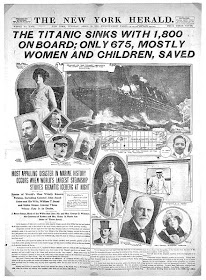 There were only lifeboats enough for 1,178 of the 2,201 souls aboard. And while many lived (and died) up to the finest traditions of Women and Children first, not all the gentlemen passengers were made of such stern fibre:
There were only lifeboats enough for 1,178 of the 2,201 souls aboard. And while many lived (and died) up to the finest traditions of Women and Children first, not all the gentlemen passengers were made of such stern fibre:[Owner Bruce] Ismay's most vocal American defender was first class passenger Billy Carter of Philadelphia, but this proved a mixed blessing. Carter turned out to be the only male passenger in Collapsible C.Requiescat in pace, to all who lost everything that cold April morning.
There were raised eyebrows about him, too, and speculation increased when Mrs. Carter sued for divorce in January 1914. Every effort was made to keep the details secret, but it was rumored that Titanic played a part in the case.
Then on January 21, 1915, somebody - no one is sure who - released Mrs. Carter's testimony. The grounds for her suit were "cruel and barbarous treatment and indignities to the person," and one passage in particular caught the public's eye:
When the Titanic struck, my husband came to our stateroom and said, "Get up and dress yourself and the children." I never saw him again until I arrived on the Carpathia at 8 o'clock the next morning, when I saw him leaning on the rail. All he said was that he had had a jolly good breakfast, and that he never thought I would make it.
Carter denied all charges, stressing that he had had his wife and children placed into one of the boats before he and Ismay had jumped into Collapsible C to help with the rowing. A shadow of a doubt hovers over this version, since the British Inquiry established that Collapsible C left the Titanic some 15 minutes before Mrs. Carter and the children went in Boat 14.
After the divorce, Mrs. Carter married George Brooke, and lived a happily uneventful life until she died in 1934. Billy Carter, vaguely described at the time of the disaster as a polo player and clubman, continued playing polo and going to his clubs, ultimately dying in Palm Beach in 1940.
From Walter Lord's The Night Lives On, a sequel to his definitive narrative of Titanic's last night, A Night To Remember.
Interesting.
ReplyDeleteSo is this guy the basis for the coward in the movie?
Chris, I don't know. I picked up the book around 1998, when the movie craze was about at its peak. It was in paperback then, and so had obviously been out for a while.
ReplyDeleteI actually don't think that you need a particular historical figure. The story is so compelling that it almost writes itself.